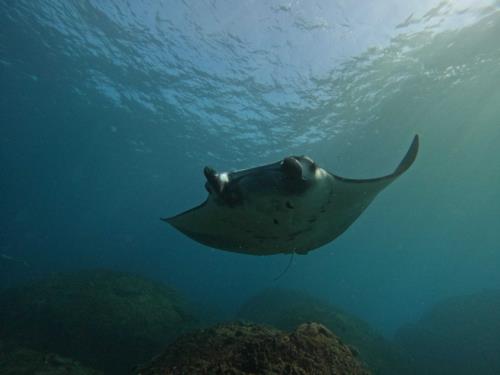
Bali isn’t just about temples, sunsets, and surfing—it’s also one of Southeast Asia’s best diving destinations. From dramatic drop-offs and colorful reefs to historic shipwrecks and thrilling pelagic encounters, the island offers something for every kind of diver. Whether you’re just getting certified or have hundreds of dives logged, Bali has a spot that will leave you in awe.
Must-Visit Dive Sites in Bali
1. Nusa Penida
Located southeast of Bali, Nusa Penida is world-famous for its strong currents and big marine life. Two sites stand out:
Manta Point: As the name suggests, this is the place to see manta rays. These gentle giants glide gracefully around cleaning stations, often coming close enough for an unforgettable experience. Sightings are common year-round.
Crystal Bay: Known for its clear visibility and occasional sightings of the elusive mola-mola (sunfish), especially between July and October. The site has vibrant coral gardens but can have strong, shifting currents perfect for experienced divers.
2. Tulamben
A calm, shore-accessible site located on Bali’s northeast coast, Tulamben is home to the USAT Liberty Shipwreck—one of the most famous wreck dives in the world. This 120-meter WWII-era cargo ship is now an artificial reef buzzing with marine life, from bumphead parrotfish to macro critters like nudibranchs and ghost pipefish. Great for all levels, including night diving.
3. Amed
Just a short drive from Tulamben, Amed is a quieter diving hub that offers stunning coral slopes, walls, and muck diving. The waters here are usually calm, making it a favorite for beginners and underwater photographers looking for macro subjects like pygmy seahorses and frogfish.
4. Padang Bai
On Bali’s east coast, Padang Bai is known for Blue Lagoon, a gentle site perfect for training dives and snorkeling. But more advanced sites like Jepun and Shark Point offer surprises like reef sharks, turtles, and schooling fish. This area is ideal for a mix of both easy and adventurous dives.
What You Can Expect to See
Bali sits within the Coral Triangle, which is the most biodiverse marine area in the world. So yes—it’s teeming with life. Depending on where and when you dive, you might see:
Manta rays (year-round in Nusa Penida)
Mola-mola (seasonal, July–October)
Turtles, reef sharks, and bumphead parrotfish
Macro life like nudibranchs, seahorses, and frogfish
Massive schools of jackfish at the Liberty wreck
Occasionally, whale sharks (though rare, they have been spotted)
Diving in Bali for Beginners
If you’re new to diving, Bali is a great place to start. Calm sites like Blue Lagoon, Jemeluk Bay, and the Liberty Wreck offer gentle conditions with excellent visibility. There are many PADI-certified dive centers, like Bali Aqua Dive Center, that offer beginner-friendly programs including Discover Scuba Diving and full Open Water Diver certification courses. The instructors here are multilingual, patient, and focused on safety.
Tips for a Safe and Enjoyable Dive Trip
Best Time to Dive: April to November is the dry season with the best conditions. Mola-mola season is from July to October.
Watch the Currents: Some sites—especially around Nusa Penida—can have strong currents. Make sure you’re diving within your certification level.
Respect Marine Life: No touching or chasing—this protects both the animals and yourself.
Surface Intervals: Allow enough time between dives and avoid flying within 18–24 hours after your last dive.
Dive with Reputable Operators: Choose experienced and certified centers like Bali Aqua Dive Center to ensure safety, equipment quality, and professional guidance.
Scuba diving in Bali offers variety, excitement, and beauty in every direction. From beginner-friendly bays to deep drift dives and world-class wrecks, there’s no shortage of underwater adventures. Add in warm waters, rich marine life, and professional dive operators, and you’ve got the perfect setup for your next dive trip.
Ready to explore? Check out Bali Aqua Dive Center for dive packages, PADI courses, and more:
baliaqua.com